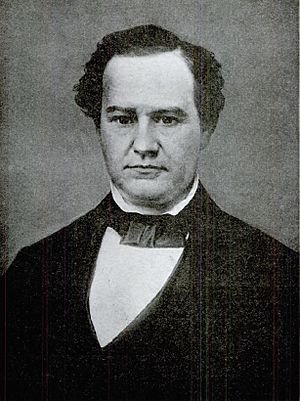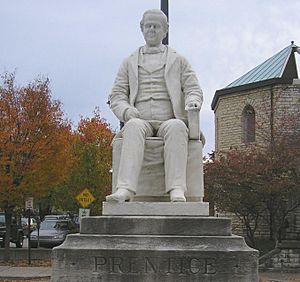George D. Prentice facts for kids
Quick facts for kids
George D. Prentice
|
|
|---|---|
 |
|
| Born |
George Dennison Prentice
December 18, 1802 Preston, Connecticut, U.S.
|
| Died | January 22, 1870 (aged 67) |
| Resting place | Cave Hill Cemetery Louisville, Kentucky, U.S. |
| Occupation | Newspaper Editor |
| Political party | Whig Know-Nothing Party Constitutional Union Party |
| Spouse(s) |
Harriet Benham
(m. 1835) |
George Dennison Prentice (December 18, 1802 – January 22, 1870) was an important newspaper editor, writer, and poet. He made the Louisville Journal a very popular newspaper in Louisville, Kentucky, and the Ohio River Valley. His strong opinions and witty writing in his newspaper articles made them famous. Some people even blamed his words for a violent riot in 1855.
Prentice owned enslaved people. Before the American Civil War, he supported Unionist candidate John Bell. After the war started, he wanted Kentucky to stay neutral. Both of his sons joined the Confederate States Army, and one died in 1862. Prentice wrote articles that made fun of Kentucky's Union military governor, General Stephen G. Burbridge. Later, he was against the government's plans for Reconstruction after the war. He wrote a book about Henry Clay in 1831 and a poem in 1836 that was in the McGuffey Readers. A collection of his funny essays was published in 1859.
Contents
Early Life and Education
George Prentice was born in New London County, Connecticut, in 1802. His parents were Rufus Prentice, a farmer, and Sarah Stanton. George was a very smart child. He learned to read before he was four years old. By the time he was fourteen, he knew Latin and Greek very well. At age 15, he was already the principal of a public school.
He later moved to Rhode Island to study at Brown University. He graduated at the top of his class in 1823. After college, he went back to Connecticut to study law. He became a lawyer in 1827, but he didn't become a successful one.
Family Life
On August 18, 1835, George Prentice married Harriet Benham. She was from Louisville, Kentucky, and was a talented musician. For 20 years, she directed the choir at Christ Church in Louisville.
George and Harriet had four children. Their first two, Mary Louise and George Benham, died when they were young. Their sons William Courtland Prentice (1837-1862) and Clarence Joseph Prentice (1839-1873) lived to be adults. In the 1840s, Prentice's household included enslaved people. By 1860, he owned four enslaved people.
Newspaper Career
Prentice moved to Hartford in 1827. He became the editor of the Connecticut Mirror and later the Hartford New England Review.
He was invited to Kentucky to write a book about Henry Clay for his political campaign. Prentice ended up staying in Louisville. His book about Clay sold many copies, but Prentice didn't get paid because the publisher went out of business.
In 1830, Prentice helped start the Louisville Journal newspaper. He wanted to support Henry Clay and compete with another newspaper, the Louisville Public Advertiser. Prentice often argued with the Advertiser's publisher, Shadrack Penn, in his articles.
Prentice's sharp writing and clever responses to his critics made the Journal very popular. It became the most widely read newspaper in western America for many years. Prentice was also a poet. His poem "The Closing Year" was even included in a McGuffey Reader, which were popular school books. He also helped and guided another poet, Mary Louisa Chitwood.
Prentice was known for his strong opinions in his newspaper articles, especially before elections. He first supported the Whig Party and became a leader in it. In 1855, as the Whig Party was breaking apart, Prentice began to support the Know-Nothing party. This party was against immigrants and Catholics.
In Louisville, this led to a violent event called Bloody Monday on August 6, 1855. Mobs tried to stop Irish and German immigrants from voting, and 22 people were killed. Days before, Prentice had written articles against "foreign swarms" who he said were loyal to the Pope. Later, Prentice said he regretted his part in the riots.
In 1857, Prentice had a pistol duel with Reuben T. Durrett because of things written in their rival newspapers. Prentice also wrote columns for the New York Ledger. In 1859, a book of his funny essays, Prenticeana: or wit and humor, was published.
Civil War and Aftermath
Prentice supported the Union in the 1850s. In the 1860 election, he supported the Constitutional Union Party. However, he disagreed with many of President Lincoln's decisions during the Civil War. He especially did not like the decision to free enslaved people.
In 1861, Prentice joined a group that wanted Kentucky to stay neutral and not join either side in the war. Even so, Union troops occupied Louisville for most of the war. Both of Prentice's sons joined the Confederate army. His older son, William, died in 1862. His son Clarence became a Major in the Confederate cavalry. In 1864, Prentice created a fictional character called "Sue Mundy" to make fun of Union General Stephen G. Burbridge, who was the military commander of Kentucky.
After the war, Prentice was against many of the government's Reconstruction policies. His newspaper was one of the few that criticized these plans to rebuild the country. In 1868, the Louisville Journal merged with two other newspapers to create The Courier-Journal. Prentice remained an editor for a short time. After his death, Henry Watterson, a Confederate veteran, became the editor.
Death and Legacy
George Prentice died from the flu on January 22, 1870. This was less than two years after his wife passed away. He was buried in Cave Hill Cemetery in Louisville.
The new editor of The Courier-Journal gave a speech and printed a tribute to Prentice. A publisher also re-released his essay collection. Over time, Prentice's reputation became less favorable. In 1993, an article about the newspaper's history called his writings "raw bigotry." A 2005 article remembered the Bloody Monday riot.
A statue of Prentice was made by Alex Bouly in 1875. It was first at the Courier-Journal building. In 1914, it was moved to the Louisville Free Public Library.
The statue has caused some debate because of Prentice's strong anti-Catholic and anti-immigrant writings. At one point, the city added a new plaque to the statue. This plaque described Prentice's "tarnished legacy." In 2018, the statue was removed and put into storage.
A Liberty ship, the SS George D. Prentice, was named after him. It was launched in 1943 and used until 1969.
Images for kids
Links
- Mary Louisa Chitwood
- Louisville in the American Civil War



